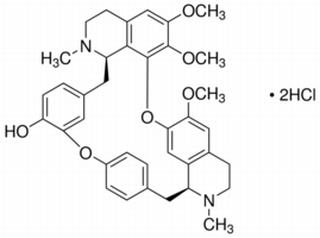Home
Products
Berbamine hydrochloride



| Product Name | Berbamine hydrochloride |
| Price: | $15 / 20mg |
| Catalog No.: | CN01374 |
| CAS No.: | 6078-17-7 |
| Molecular Formula: | C37H42Cl2N2O5 |
| Molecular Weight: | 665.65 g/mol |
| Purity: | >=98% |
| Type of Compound: | Alkaloids |
| Physical Desc.: | Powder |
| Source: | The roots of Cocculus orbiculatus (L.) DC. |
| Solvent: | Chloroform, Dichloromethane, Ethyl Acetate, DMSO, Acetone, etc. |
| SMILES: | Nc1cccc2c1C1Cc3ccccc3CN1CC2.Cl.Cl |
| Contact us | |
|---|---|
| First Name: | |
| Last Name: | |
| E-mail: | |
| Question: | |
| Description | Berbamine dihydrochloride is an inhibitor of NF-κB activity with remarkable anti-myeloma efficacy. |
| Target | NF-κB Autophagy |
| In Vitro | Berbamine, a novel NF-κB inhibitor, inhibits growth and induces apoptosis in human myeloma cells. Berbamine treatment leads to increased expression of A20, down-regulation of IKKα, p-IκBα, and follows by inhibition of p65 nuclear localization. As a result, NF-κB downstream targets such as cyclin D1, Bcl-xL, Bid and survivin are down-regulated. To determine whether Berbamine has growth inhibitory effect on myeloma cells, KM3 cells are treated with Berbamine at various concentrations for 24, 48, and 72 h, respectively, and then cell viability is assessed by MTT assays. Berbamine inhibits the growth of KM3 cells in a dose- and time-dependent manner, and the IC50 values are 8.17 μg/mL, 5.09 μg/mL, and 3.84 μg/mL for treatment of 24, 48, and 72 h, respectively. In contrast, IC50 value of Berbamine for normal hematopoietic cells is 185.20 μg/mL at 48 h[1]. |
| In Vivo | Berbamine (BBM) is a natural bisbenzylisoquinoline product isolated from traditional Chinese herbal medicine Berberis amurensis and has been used to treat inflammatory and other diseases.The anti-tumor effects of Berbamine are determined on a xenograft animal model. Two liver cancer cell lines, Huh7 (epithelial) and SK-Hep-1 (mesenchymal-like), are inoculated into NOD/SCID mice by subcutaneous injection. The oral Berbamine treatment greatly suppresses the growth of Huh7 xenografted tumors over the time and leads to a tumor reduction by 70% based on the tumor weight. The growth of SK-Hep-1 cells in NOD/SCID mice is less sensitive to Berbamine than that of Huh7. There is a significant suppression of the growth of the SK-Hep-1 xenograft with more than 50% reduction of the tumor weight[2]. |
| Cell Assay | The inhibitory effect of Berbamine on growth of KM3 cells is measured by MTT assay. Briefly, KM3 cells (8×103 per well) are incubated with increasing concentrations of Berbamine (1-32 μg/mL) for 24, 48, or 72 h and then pulsed with 20 μL of 5 mg/mL MTT for the last 4 h, 200 μL DMSO is then added to dissolve the formazan crystals. Dye absorbance in viable cells is measured at 570 nm, and then the inhibitory concentration of 50% (IC50) is calculated[1]. |
| Animal Admin | Mice[2] 5×106 Huh7 cells in 50% Matrigel dissolved in PBS are inoculated in a NOD/SCID mice. 5×106 SK-Hep-1 cells are applied for each xenograft without Matrigel. 100 mg/kg of Berbamine is orally treated to mice with a regimen of twice a day for 5 consecutive days after the tumors reach a size of 2 mm in diameter. After 2 days withdraw, the regimen is repeated once[2]. |
| Boiling Point | 744.4ºC at 760 mmHg |
| Flash Point | 404ºC |
| PSA | 72.86000 |
| LogP | 7.53720 |
| Storage condition | -20°C |